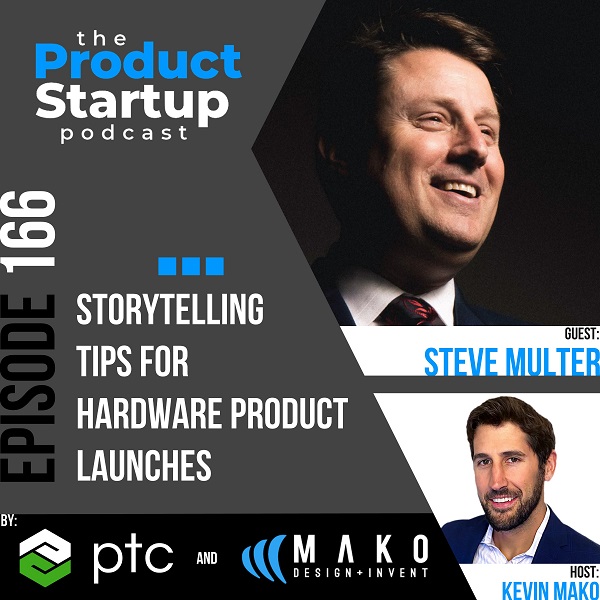With Steve Multer, Author & Corporate Storyteller
Hosted by Kevin Mako, President of MAKO Design + Invent

Steve Multer is the author of “Nothing Gets Sold Until The Story Gets Told,” which is now available for purchase on Amazon and other major book retailers. With over 20,000 presentations delivered and extensive collaborations with over 100 leading hardware brands, including Cisco, Panasonic, Siemens, HP, Philips, and Xerox, Steve has perfected his skills in developing product and brand messaging. Today, he will be sharing his knowledge of corporate storytelling with inventors, startups, and small manufacturers. In this session, he will highlight the essential elements of a well-crafted sales or brand story and provide the best practices for launching a new hardware product while maintaining long-term customer engagement and brand loyalty.
Today you will hear us talk about:
- What is Corporate Storytelling?
- How to understand product metrics and corporate storytelling, as well as how to tailor brand messaging to investors and the public.
- The significance of audience awareness and how to meet their expectations through storytelling.
- The 3 essential pillars of a compelling story: Value, Passion, and Connection.
- How to use your product to create positive change in people’s lives.
- What is the importance of personal passion in advertising and branding?
- It is key to connect with your audience through these stories that resonate with them and invite participation.
- Effective advocacy for your hardware product can be achieved through authentic storytelling.
- Investors are always going to be interested in the human elements of a product.
- How to craft a cohesive narrative by combining your product and storytelling.
- How to achieve sales through storytelling techniques and the power of narrative.
- Core strategies for ensuring customer retention.
- How to grow your hardware product and brand for the long term.
- Building a community that will support your product venture will help you succeed.
- Passionate storytelling plays a critical role in securing buy-in from stakeholders, buyers and investors.
EPISODE HIGHLIGHTS
- 1:00 – Hardware is now developed iteratively, but there are tools to do it the best way in 2023
- 3:00 – Hardware product development iteration is historically rigid and difficult
- 3:15 – Ideally you want to be nimble and be able to meet customer demand, or other market demands.
- 4:30 – What is iterative design between manufacturing runs?
- 4:40 – Legacy hardware design is through waterfall methodologies. Releases are planned well in advance and thus iterative design and feedback is very rigid.
- 5:00 – Modern hardware development takes from the software playbook
- 5:25 – It is easier than ever, due to manufacturing technology, to get iterative designs back to review and improve. More confidence to iterative and move forward with a new design.
- 5:30 – Quick assemblies, 3D printing, low quantity builds, short run manufacturing
- 6:00 – The pandemic forced people to be agile in development given that many supply chain issues forced legacy processes to upgrade to iterative design logic.
- 6:55 – There is a ton of new technology both in design and manufacturing to be able to iterate your product efficiently.
- 7:05 – Short run production is so valuable to iterative physical product design and development.
- 7:30 – Planning your product lifecycle well in advance is not realistic unless you can pay millions on consultants and data to ensure you’re properly making those predictions so early, and even so, the information will be weaker than iterating in real-time based on real market needs.
- 8:30 – There are many different stakeholders which should weigh into the feedback between each iterating in design: The customer, industrial design, mechanical engineering, electronics engineering, software, manufacturing, product managers, investors, the inventor, employees, etc.
- 8:50 – Make sure you get engineers in front of customers that have bought your prior versions of the product.
- 9:55 – Who are your existing customers and who are your potential customers.
- 10:10 – Feedback can be both problems that need to be solved but also opportunities for new features.
- 10:50 – Make sure you are at least first being sure that you are collecting feedback information.
- 11:00 – After you collect feedback information, how do you organize and prioritize that information, so that you can eventually execute on that information properly.
- 11:30 – A foundation of organization is revision control.
- 14:40 – Collaboration is the next key pillar of iterative design, built on the foundation of revision history.
- 17:00 – How do you then prioritize the collaborated information. Priority labels and importance.
- 19:00 – Even if you’re just a new hardware startup, you can use these processes in a simple spreadsheet to improve the output of your physical product development processes.
EPISODE LINKS
Steve Multer Links:
LinkedIn | Book
The Product Startup Podcast Links:
https://www.ProductStartup.com/
Instagram | LinkedIn | Facebook Page | Facebook Group | Pinterest | Twitter | YouTube
PTC Links:
https://www.ptc.com/
OnShape | Creo
Mako Design Links:
https://www.makodesign.com/
YouTube | Instagram | LinkedIn | Facebook | Pinterest | Twitter
Kevin Mako Links:
Instagram | LinkedIn | Quora | Facebook | Twitter
Partner: PTC’s best-in-class software solutions Onshape: The only cloud-native product development platform that delivers full-featured computer-aided design (CAD), integrated product data management (PDM) and enterprise analytics in a single system, and Creo: 3D CAD solution that provides designers with the most innovative tools to build better products faster, such as generative design, additive manufacturing, real-time simulation, IIoT, and augmented reality.











